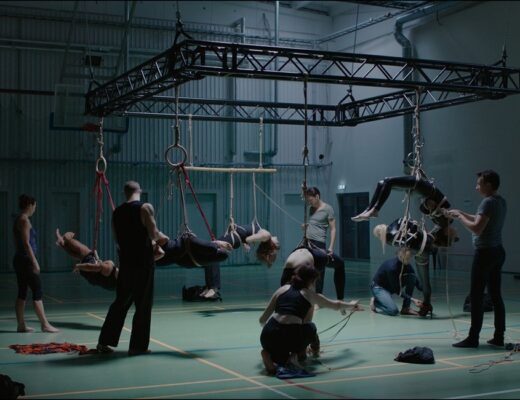Both Sides of the Blade is a work of true entropy, a unique film in Denis’ oeuvre that leverages a newfound sense of languor to great effect.
The past is something of a structuring absence in the work of Claire Denis. In her films, narratively important events and actions are elided with frequency, leaving a profound immediacy focused on present-tense gestures that only reveal their connective seams and emotional logic after the fact. Leaving the theater is akin to waking up from a dream and finally grasping the semi-logical chain of events that leads from one intense moment to another. Yet it is precisely in the cut, and all the absent time it implies, where much of her films’ emotional potency lies. In Denis’ first collaboration with Juliette Binoche, Let the Sunshine In, an erotic first encounter is followed by a cut to the exasperated ending of the weeks-long romance that follows. The potency of the moment comes not from the antipathy they now feel toward each other, but from the feeling of time evading us — all of those plain moments of being together which constituted their brief relationship getting subsumed by the emotional highs of an ecstatic first meeting and a bitter goodbye.
Both Sides of the Blade, her most recent collaboration with Binoche and the writer of Let the Sunshine In, Christine Angot, is fixated on this idea of a mysterious yet powerful past that holds sway over us, whether we care to admit it or not. For Binoche’s character in this film, Sara, the return of the repressed comes in the form of François (Grégoire Colin), a former lover who sends her into a near panic attack after she glimpses him on the street. Sara is happily partnered with François’ ex-best friend Jean (Vincent Lindon), and when she tells Jean that she has no interest in François anymore, everything in her expression tells us that she means it. Yet every small movement that puts her closer to François reveals more concealed passions, creating subtle shifts in her inner emotional life that make large ripples into her relationship with Jean.
Infidelity is of little concern here, and the actual consummate reality of the affair carries scant emotional importance in the film. While her infidelities with François may be contradictory with her assurances of devotion to Jean, Denis is careful never to frame Sara as duplicitous. Instead, she presents Sara’s pursuit of her irreconcilable desires as a gesture of earnestness. Even after we’ve seen Sara consummate her affair, the panicked trembling of her denials convince us that she means every word she says despite our knowledge to the contrary. It is precisely this discordance of her emotions that propels the film forward toward a tragedy that feels unavoidable and futile.
Shot during the long Covid winter of 2020/2021, when cases were at their pre-vaccine peak, Both Sides of the Blade is defined by a sense of terminal weariness. We’re given a glimpse of what seems like happiness at the film’s opening — a short, lyrical portrait of Sara and Jean swimming in sunny Corsica — but this soon feels like a distant dream amidst the endless grays of one wintry Parisian twilight after another. Aiding matters is Denis’ claustrophobic treatment of the material, setting the bulk of the drama amidst the drab white of Sara and Jean’s penthouse apartment where the walls can, at times, seem to swallow the whole frame. Here, the couple trudge through one circular conversation after another, with each new scene only bringing subtle shifts in their relationship while further heightening the hopelessness of their attempts to figure things out.
While the term late style may be bandied around too much these days — is cinema itself, facing the death of movie theaters, in a period of late style? has it always been? — there is something apt in affixing it to the 76-year-old director’s film. There is something of the death drive lying behind many of her movies — from the French Foreign Legion’s reluctance to accept the end of French colonialism in Beau Travail to Robert Pattinson’s journey into the depthless void of space in High Life — yet this latest effort feels like a work of true entropy. Unlike the jittery jumps through time and space or the poetic montages of bodies and landscapes graphically arranged to externalize dense psychic geographies, Both Sides of the Blade exhibits an understated languor unique amongst her films. Scenes simply stroll along, the tension set to a slow simmer, while subplots casually weave in and out of the main action without ever fully connecting in a discernible way. Even the cinematography by Éric Gautier bears an offhanded quality, preferring a semi-traditional deployment of medium close-ups throughout the domestic scenes as opposed to the shaky opacity of Agnes Godard’s work on any number of Denis’ films from L’Intrus to Bastards. This is fitting for a portrait of a character and a world that is defined by its terminality; a movie where, when the end credits roll, you feel like there is truly nothing left. Sara, Jean, and François have all become characters without a future.







